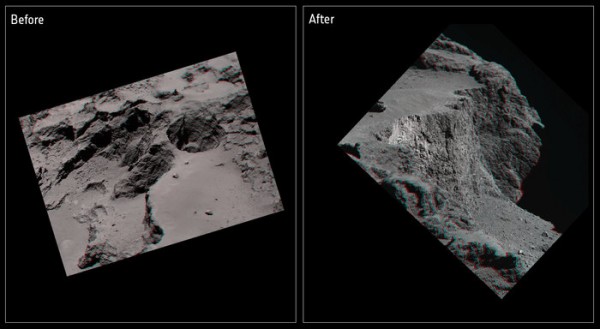By Ana Verayo, | March 22, 2017

Anaglyph images of the Aswan cliff showing the overhang before (left) and after (right) it collapsed.
For the first time ever, a landslide on a comet has been recorded by scientists, revealing stunning imagery of a violent collapse on a 100 meter long cliff. Scientists reveal these new images courtesy of the Rosetta spacecraft.
European Space Agency's Rosetta spacecraft captured this incredible cosmic event on comet 67P/Churyumov-Gerasimenko where the probe also took a series of before and after shots. The images reveal a dusty avalanche that exposed a new patch of fresh ice from the comet's interior.
Like Us on Facebook
Astronomers suggest that this landslide was caused by a comet outburst within the same region in that same location as jets of gas and dust were ejected by the comet. This phenomenon occurs when comets arrive near the sun and as its surface gets heated, when cliffs or mounds of rock and rubble crumble as these structures shift.
Scientists compare these comet outbursts to geysers found on Earth where pressurized, hot gas blasts off from the comet's interior when the surface gets heated. Now, these recent observations show that this cliff called Aswan located in a "wing" area of the oddly shaped comet.
Rosetta's onboard camera recorded a large dust plume last July 10, 2015. After five days, the Aswan cliff collapsed as revealed by new images, that suggests that this outburst was directly linked to this landslide. According to lead author of the study, Maurizio Pajola of the NASA Ames Research Center, this is the most compelling evidence of an observed outburst that resulted in a cliff collapse in the same location.
Astronomers also revealed that during July 2015, the Aswan cliff region's temperatures rose from negative 142 degrees Celsius to 46 degrees Celsius in just 20 minutes. This occurred when the comet's surface suddenly appeared from its shadow and into direct sunlight. In addition, this cliff was directly heated and illuminated for 1.5 hours for every 12 hours that also accelerated the formation of fractures on the surface of the comet.
After more than 12 years of travelling in space to arrive at Comet 67P, ESA's Rosetta mission ended last September. The Rosetta spacecraft spent two years orbiting the comet and even deployed a small robotic lander known as Philae on the surface of the comet.
This new study is published in the journal Nature Astronomy.
-
Use of Coronavirus Pandemic Drones Raises Privacy Concerns: Drones Spread Fear, Local Officials Say

-
Coronavirus Hampers The Delivery Of Lockheed Martin F-35 Stealth Fighters For 2020

-
Instagram Speeds Up Plans to Add Account Memorialization Feature Due to COVID-19 Deaths

-
NASA: Perseverance Plans to Bring 'Mars Rock' to Earth in 2031

-
600 Dead And 3,000 In The Hospital as Iranians Believed Drinking High-Concentrations of Alcohol Can Cure The Coronavirus

-
600 Dead And 3,000 In The Hospital as Iranians Believed Drinking High-Concentrations of Alcohol Can Cure The Coronavirus

-
COVID-19: Doctors, Nurses Use Virtual Reality to Learn New Skills in Treating Coronavirus Patients







